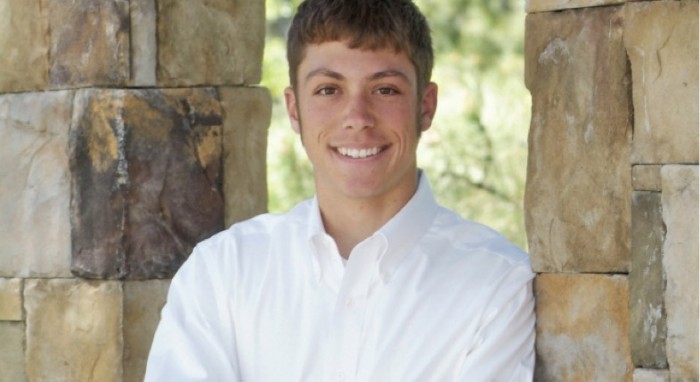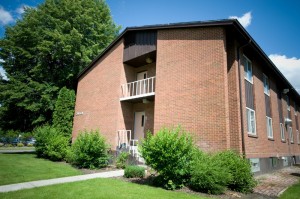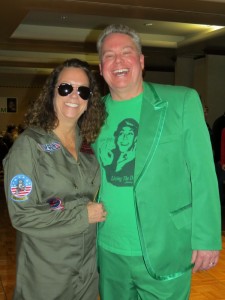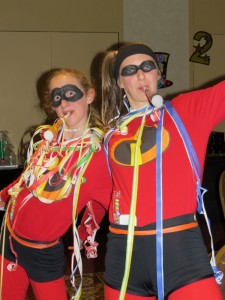Every time Mary Kay McGann calls her son’s cell phone, she inevitably gets his voicemail. The personalized automated response says, “Hey, it’s Jimmy. I’m just chillin’ and living the dream.” Mary Kay just smiles. That’s classic Jimmy, out savoring every second of his unencumbered youth, not worrying about the curveballs life can sometimes throw.
Jimmy had no reason to suspect a curve. Even if he saw one coming, his days as a baseball player had taught him how to handle it. Just wait long enough to judge the break of the ball. Thing is, you can only wait so long. You eventually have to swing. Sometimes, though, even your best cut is not good enough.
***
Mary Kay and her husband, Jim, are, in spirit at least, East Coasters. She is from upstate New York and he is a Long Island boy. Even though they moved their family to Colorado 13 years ago, you can still detect that distinctive New York accent when they speak. It is no wonder, then, they could not hide their love for the region when Jimmy, the oldest of their four children, was deciding where to attend college.
“When it came time for school,” Mary Kay said, “his father brainwashed him and said, ‘You know, all the good schools are in the East.’ ”
“I told him I didn’t even know there were universities west of the Mississippi,” Jim added.
Jimmy, a senior at Regis Jesuit High School in the Denver area at the time, applied to only one school in the West, Gonzaga University. His top choice was The Catholic University of America in Washington D.C., where he planned to play on the baseball team. About three weeks before his tuition deposit was due, though, Jimmy came home and told his parents he had changed his mind. He was going to Gonzaga.
“Jim popped a gasket,” Mary Kay said.
“I didn’t pop a gasket,” Jim countered. “Now, I did try to talk him out of it.”
There was no changing Jimmy’s mind. He told his parents that when he stepped on campus for the first time during his initial visit, he knew instantly he belonged at Gonzaga.
“It was the only place he ever wanted to be,” Mary Kay said. “He was only here a year, but he loved it.”
***
It started as a dull ache in Jimmy’s back, the kind you get when you pull a muscle. Only it did not go away. It was May 2008, and Jimmy had just completed his freshman year at Gonzaga.
He lived in Campion House, a bit of a disappointment at first because he did not want to be in an all-boys dorm. But the guys in Campion quickly became Jimmy’s new family. They did everything together. They studied, partied and, of course, went to basketball games. Jimmy was truly living the dream.
He flew home to Denver for the summer, where the nagging pain in his back worsened. On May 11, Mother’s Day, he went to the emergency room. It was shortly after that visit to the hospital that he started writing a blog to detail the next nine months of his life.
“I went to urgent care and then the emergency room at the hospital to get my back pain figured out and hopefully fixed,” Jimmy wrote. “Well, as it turns out, this pain was telling my body that I was about to begin the biggest battle of my life.”
Jimmy had advanced testicular cancer. The pain in his back was from tumors growing on his lymph nodes. Worse yet, it had already spread to other parts of his body, including his lungs.
Each year, about 8,000 men in the United States are diagnosed with testicular cancer. It has one of the highest cure rates of all forms of cancer: in excess of 90 percent overall and nearly 100 percent if the cancer has not metastasized. Even for the relatively few cases in which malignant cancer has spread widely, modern chemotherapy offers a cure rate of around 80 percent.
Just eight days after the initial diagnosis, and only seven days after an operation to remove the source of the cancer, Jimmy started his first round of chemotherapy. For five straight days, Jimmy received an intravenous concoction of cancer-fighting drugs. Each daily session usually lasted five to six hours. He shared the experience on his blog.
“I know everyone wants to know how the chemo was. Well, it really does not hurt when they are shooting it into me, but as the days progress, there were many times when I felt sick to my stomach, really tired and just like I have a bad flu.”
He would undergo three more rounds of planned chemotherapy over the next three months. He endured the usual loss of weight and hair. More disconcerting was his weakened immune system, the result of an extremely low number of white blood cells, and blood clots in his lungs.
“Life is like a baseball game,” Jimmy wrote, “and this battle I am in against my cancer is just one inning! We will win the game!”
***
In recent years, Jim and Mary Kay have developed a bit of an affinity for philanthropy. They have participated in Relay for Life, the main volunteer-led fundraising event of the American Cancer Society, and they have even organized fundraising events to help out Regis, Jimmy’s old high school.
Not too long ago, they decided to establish an endowed scholarship at Gonzaga. They witnessed firsthand what the school, and more importantly, what the people at the school meant to Jimmy. In fact, when he was first diagnosed with cancer, he wanted to do his treatment in Spokane.
“I think he instantly had a bunch of guys that he immediately bonded with,” Jim said. “Even the school stuff, there were a couple of teachers that he connected with.”
“That’s how much he liked Gonzaga,” Mary Kay added. “He just didn’t understand why he couldn’t do his chemo here. That was the only thing we fought about. I just said, ‘Jimmy, you can’t do it there, you just can’t. I’m still your mother and you still have to listen to me.’ ”
Their son’s love for his school is what inspired Jim and Mary Kay to give back to Gonzaga. They just never imagined it would be under these circumstances.
***
By the end of the summer, Jimmy had every reason to be optimistic. Treatment had gone well.
He had regained 15 pounds, an encouraging sign, and the status of his tumor markers had either lowered or remained steady during each round of chemo.
But cancer had an unshakable grip on Jimmy. His team of doctors in Denver recommended he go to Indianapolis to see Lawrence Einhorn, a cancer guru and the same doctor used by Lance Armstrong. In 1974, Einhorn pioneered the development of the life-saving treatment for testicular cancer, increasing the survival rate from only 10 percent to more than 90 percent. Einhorn planned to battle Jimmy’s cancer with high-dose chemotherapy and stem cell transplants.
“I looked at him,” Mary Kay recalled, “and said, ‘as a mom I feel terrible. How could this have happened? How could I have not known?’ ”
Dr. Einhorn told Mary Kay that Jimmy’s cancer was atypical. It could have been in his body for as few as 10 weeks before the pain in his back started. It was, he said simply, bad luck.
Throughout all of this, Jimmy never wavered in his belief that he would beat cancer. The prayers from family and friends, and his faith in God, kept him strong.
“I’ll go to any doctor,” Jimmy told his mom. “But it’s not up to them — and that’s OK.”
Jimmy was upset about only one thing. Starting two more rounds of aggressive and specialized treatment halfway across the country meant he would not be returning to Gonzaga for his sophomore year.
“As I go on the road to finish this inning, there may be some cancer left in me,” Jimmy wrote, “but there is something else inside me, which is a big-time desire to never stop living the dream!”
***
Jimmy’s blog entry from Oct. 6, 2008: “Now for the great news … my tumor marker is now at the lowest it ever has been and that is exactly where Dr. Einhorn thought it would be. I am really excited because I am about to jump on home plate and declare victory on this tough inning in my life.”
Three weeks later, Jimmy’s tumor markers began to rise. Back to Indianapolis for more chemo and, of course, more IVs, more infections and more nausea. This was Jimmy’s routine. His life was an endless battle for life.
“Through the nine months never once did he think he was going to lose,” Mary Kay said. “He was never mad or pissed off. He was going to beat it.”
Jimmy was also going to dance. He danced with his friends at the Charity Ball when he made a surprise visit to Gonzaga in December. He danced at his family’s legendary New Year’s Eve party. It was a tradition that started humbly in the McGann’s garage. It now includes costumes, contests, board games and a DJ. The family rents a hotel ballroom to accommodate the hundreds of neighbors and friends who join the celebration. It was always Jimmy’s favorite day of the year.
On Jan.8, 2009, Jimmy informed his blog followers that his tumor markers “shot through the roof to levels that I have never experienced.” Five days later, Jimmy lost his battle with cancer. He was 19 years old. The final post on his blog, penned by his father, begins, “The inning is over for Jimmy and the game continues for us.”
***
Jimmy’s parents have been back to Gonzaga a handful of times since his death, including May 2011 when they attended his class’ graduation ceremony. They accepted an honorary degree on Jimmy’s behalf.
“It was awesome,” Jim said. “But you’re also sitting there saying, ‘He is supposed to be there. He is supposed to be with his friends, having fun and graduating.’ ”
In February, Jim and Mary Kay attended their first Gonzaga basketball to celebrate what would have been Jimmy’s 24th birthday. Every time they return to campus, they try to do the things their son would have done. When they do, they see more and more why this was such a special place to him. That served as the inspiration to make certain Jimmy was always a part of Gonzaga.
“We said, ‘What is the one last thing that we could do for Jimmy? How awesome would it be to have a scholarship attached to his name?’ ” Mary Kay said.
In 2010, a year after Jimmy’s death, Jim and Mary Kay set out to establish the Jimmy McGann Scholarship. They needed $25,000 to endow the fund. An anonymous donor pledged to pay the sum over five years, which left Jim and Mary Kay overwhelmed. But they wanted to see the benefits of the scholarship as soon as possible.
To accelerate the process, they came up with the idea to turn their well-known New Year’s party into a fundraising effort. The 2012 gala generated more than $6,000, enough to help the McGanns meet the amount required to endow Jimmy’s scholarship after just two years. The fund, reserved for young men from Regis Jesuit High School, awarded its first scholarship in the fall of 2013.
“I’m sure Jimmy is saying, ‘Gee, a scholarship with my name on it,’ ” Mary Kay said. “It will be great because we still know people at Regis and it is going to be so great for that boy to have the opportunity to go to Gonzaga.”
Jimmy never did touch home plate, but this scholarship is just one of the many ways his legacy will live on. Even five years after his father made the final post on Jimmy’s blog, people still leave messages on the site. There are more than 500, some posted as recently as February of 2013. One reads, “Hi, Jimmy, I haven’t been here in a while, but that doesn’t mean I don’t think of you every day. Thank you for all the signs of your love … your timing is always perfect. It always helps to feel you close by, watching over us. Love you tons, always.”
***
Mary Kay still calls Jimmy’s cell phone from time to time. The personalized automated response is the same as it was before. Now it is a reminder of a son who inspired his family and friends, loved his school and, most importantly, treasured every precious moment of life.
“I haven’t turned it off because I can call it and hear it: ‘Hey, it’s Jimmy. I’m just chillin’ and living the dream.’ ”
Support the Jimmy McGann Scholarship.



